Evaluation of Functional and Spatial Characteristics of Historical Underground Mining Workings in the Context of Selecting a New Utility Function
Abstract
1. Introduction
2. Classification of Underground Excavations
3. Recognition and Identification of Spatial Structures in Underground Excavations
4. Functional–Spatial Diagnostics of Underground Spaces
- -
- The continuation or restoration of their historical function;
- -
- Non-invasive work methods;
- -
- The preservation of spatial and structural neutrality;
- -
- The enhancement of cultural and material values;
- -
- The maintenance of aesthetic integrity, including the protection of historical authenticity;
- -
- The implementation of reversible modifications;
- -
- The concealment of undesirable elements rather than their removal;
- -
- A rescue program for objects threatened by natural degradation [9].
5. Selection of a New Function—Functional–Spatial Program
- -
- Analysis of geological/geotechnical conditions: the state of preservation of the rock mass, a hazard analysis, an assessment of user safety, and an evaluation of the impact of protective works on the preservation of the spatial structure;
- -
- Ensuring safety: adapting the object to the requirements of construction and mining regulations;
- -
- Geometrical analysis of the workings: determining the adjustment of technical possibilities;
- -
- Technical infrastructure: assessing the functionality of the existing technical infrastructure;
- -
- Assessment of adaptive interference: the impact of protective and adaptive works on the preservation of underground heritage (cultural and natural) during the adaptation process, including evacuation and fire safety;
- -
- Landscape value: protection of local panoramas, views, landmarks, surroundings, etc.;
- -
- Emphasizing natural values: preserving the authentic spatial structure while considering geo-diversity;
- -
- Visibility of cultural values: preserving the technical heritage value (e.g., mining heritage) through maintaining authenticity and integrity, allowing for its recognition (Figure 10);
- -
- Maintaining cultural diversity: preserving the underground object in the public space and landscape and securing a record of its meanings and traditions according to memories, customs, and practices;
- -
- Protection and preservation of movable objects: completing an inventory, holding an in situ exhibition, and recycling—reusing elements such as preserved mining supports and technical infrastructure as elements of designed architectural details and the interior architecture;
- -
- Shaping underground space with light: assessing the potential for implementing solutions enabling its safe use;
- -
- Social conditions: assessing the real and identified needs of the local community;
- -
- Political dimension: shared cultural and natural heritage; the identification of identity and generational links;
- -
- Development of tourism potential: generating new jobs, creating a new brand, developing traditional crafts, promoting qualified underground tourism and new thematic trails, and utilising microclimatic conditions for natural healing [22];
- -
- Cognitive and educational value: the presentation and contextual popularization of its geo-diversity values, technofacts (historical mining support structures, technical equipment, and methods of rock mass exploitation), and traditions through interpretative communications and presentation methods—3D mapping, reenactments, theatrical and museum-like space presentations (light/sound performances), sensory contact (hands-on) with movable heritage, shaping with light (geospatial illumination), local ceremonies related to the traditions of the site (recreating historical crafts), and the preservation of the cultural heritage of the region (the traditional behaviours of professional groups), etc.
- -
- Natural—morphostructure, hydrological conditions, geotechnical conditions, the geodiversity of the underground environment, etc.;
- -
- Cultural—resulting from human intervention in the underground object’s space (both passive and active)—volume, surface area, proportions, lighting, etc.
6. Conclusions
Author Contributions
Funding
Institutional Review Board Statement
Informed Consent Statement
Data Availability Statement
Conflicts of Interest
References
- Chmura, J.; Wieja, T. Górnicze metody zabezpieczania i rewitalizacji podziemnych obiektów zabytkowych. Ochr. Zabyt. 2010, 1-4, 245–254. [Google Scholar]
- Schubert, M.; Paffenholz, J.-A.; Langefeld, O. Investigation of Historic Mining Infrastructure in the Upper Harz Mountains and Development of Repurposing Concepts; Mining Report Glückauf; Bergbau-Verwaltungsgesellschaft mbH: Senftenberg, Germany, 2024; Volume 160, p. 372381. [Google Scholar]
- Liessmann, W. Historischer Bergbau im Harz; Springer: Berlin/Heidelberg, Germany, 2010. [Google Scholar] [CrossRef]
- Sutrisno, A.D.; Chen, Y.J.; Suryawan, I.W.K.; Lee, C.H. Building a Community’s Adaptive Capacity for Post-Mining Plans Based on Important Performance Analysis: Case Study from Indonesia. Land 2023, 12, 1285. [Google Scholar] [CrossRef]
- Konieczna-Fuławka, M.; Szumny, M.; Fuławka, K.; Jaśkiewicz-Proć, I.; Pactwa, K.; Kozłowska-Woszczycka, A.; Joutsenvaara, J.; Aro, P. Challenges Related to the Transformation of Post-Mining Underground Workings into Underground Laboratories. Sustainability 2023, 15, 10274. [Google Scholar] [CrossRef]
- Finucane, S.J.; King, J.C.; Tarnowy, K.M. The 5R Model: Facilitating decision-making on repurposing of industrial and ancillary infrastructure. In Mine Closure 2022: Proceedings of the 15th International Conference on Mine Closure; Australian Centre for Geomechanics: Perth, Australia, 2022; Volume 1, pp. 295–306. [Google Scholar]
- Finucane, S.J.; Tarnowy, K. New uses for old infrastructure: 101 things to do with the ‘stuff’ next to the hole in the ground. In Mine Closure 2019: Proceedings of the 13th International Conference on Mine Closure; Australian Centre for Geomechanics: Perth, Australia, 2019; Volume 2019, pp. 479–495. [Google Scholar]
- Zachwatowicz, J. Program i Zasady Konserwacji Zabytków; PIHS: Islamabad, Pakistan; ZAP: London, UK; HS PW: Warszawa, Poland, 1946. [Google Scholar]
- Wieja, T. Ochrona i Adaptacja Zabytkowych Podziemnych Wyrobisk; Wydawnictwo AGH: Kraków, Poland, 2019; Available online: https://wydagh.agh.edu.pl/produkt/824-ochrona-i-adaptacja-zabytkowych-podziemnych-wyrobisk (accessed on 3 March 2025).
- Radziejowska, A.; Wieja, T. Cause-and-effect Analysis of Anthropogenic and Natural Aspects in the Process of Assessing the Material Heritage Resource in Underground Mining Adaptation Planning. Civ. Environ. Eng. Rep. 2024, 34, 449–461. [Google Scholar] [CrossRef]
- Ostręga, A.; Szewczyk-Świątek, A.; Cała, M.; Dybeł, P. Obsolete Mining Buildings and the Circular Economy on the Example of a Coal Mine from Poland—Adaptation or Demolition and Building a new? Sustainability 2024, 16, 7493. [Google Scholar] [CrossRef]
- Geological and Mining Law Act. Ustawa Prawo geologiczne i górnicze, Poland. 2011; pp. 1–266. Available online: https://isap.sejm.gov.pl/isap.nsf/DocDetails.xsp?id=wdu20111630981 (accessed on 2 January 2025).
- Construction Law Act. 7.07.1994 r., stawa z dnia 7 lipca 1994 r. Prawo budowlane. 2021; pp. 1–140. Available online: https://isap.sejm.gov.pl/isap.nsf/DocDetails.xsp?id=wdu19940890414 (accessed on 2 January 2025).
- Nature Conservation Act. Ustawa z Dnia 27 Kwietnia 2001 r. Prawo Ochrony Środowiska. Available online: https://isap.sejm.gov.pl/isap.nsf/DocDetails.xsp?id=wdu20010620627 (accessed on 12 February 2025).
- Environmental Protection Act. Ustawa z Dnia 16 Kwietnia 2004 r. o Ochronie Przyrody. Available online: https://isap.sejm.gov.pl/isap.nsf/DocDetails.xsp?id=wdu20040920880 (accessed on 12 February 2025).
- Protection of Monuments and the Care of Monuments Act. Ustawa z Dnia 23 Lipca 2003 r. o Ochronie Zabytków i Opiece Nad Zabytkami. Available online: https://isap.sejm.gov.pl/isap.nsf/DocDetails.xsp?id=wdu20031621568 (accessed on 12 February 2025).
- The Technical Conditions That Should Be Met by Buildings and Their Location Regulation. Rozporządzenie Ministra Infrastruktury w Sprawie Warunków Technicznych, Jakim Powinny Odpowiadać Budynki i Ich Usytuowanie. 2019; pp. 1–112. Available online: https://isap.sejm.gov.pl/isap.nsf/DocDetails.xsp?id=WDU20220001225 (accessed on 2 January 2025).
- Regulation of the Minister of the Environment on the Mining Plant Operation Plans. Rozporządzenie Ministra Środowiska w Sprawie Planów Ruchu Zakładów Górniczych. 2017. Available online: https://isap.sejm.gov.pl/isap.nsf/DocDetails.xsp?id=WDU20170002293 (accessed on 2 January 2025).
- Serda, M.; Szmygin, B.; Molski, P. Zamki w Ruinie—Zasady Postępowania Konserwatorskiego; Uniwersytet Śląski: Katowice, Poland, 2012; Volume 7, pp. 343–354. [Google Scholar]
- Constructive Conservation|Historic England. Available online: https://historicengland.org.uk/images-books/publications/constructive-conservation-sustainable-growth-historic-places/ (accessed on 12 February 2025).
- Regulation on the Detailed Scope and Form of Project Documentation, Technical Specifications for the Execution and Acceptance of Construction Works, and the Functional and Utility Program. 2.09.2004. Rozporządzenie Ministra Infrastruktury z Dnia 2 Września 2004 r. w Sprawie Szczegółowego Zakresu i Formy Dokumentacji Projektowej, Specyfikacji Technicznych Wykonania i Odbioru Robót Budowlanych Oraz Programu Funkcjonalno-Użytkowego. Available online: https://isap.sejm.gov.pl/isap.nsf/DocDetails.xsp?id=WDU20042022072 (accessed on 12 February 2025).
- UNESCO. Operational Guidelines for the Implementation of the World Heritage Convention; UNESCO: Paris, France, 2012. [Google Scholar]
- Didier, C. Postmining Management in France: Situation and Perspectives. Risk Anal. 2009, 29, 1347–1354. [Google Scholar] [CrossRef] [PubMed]
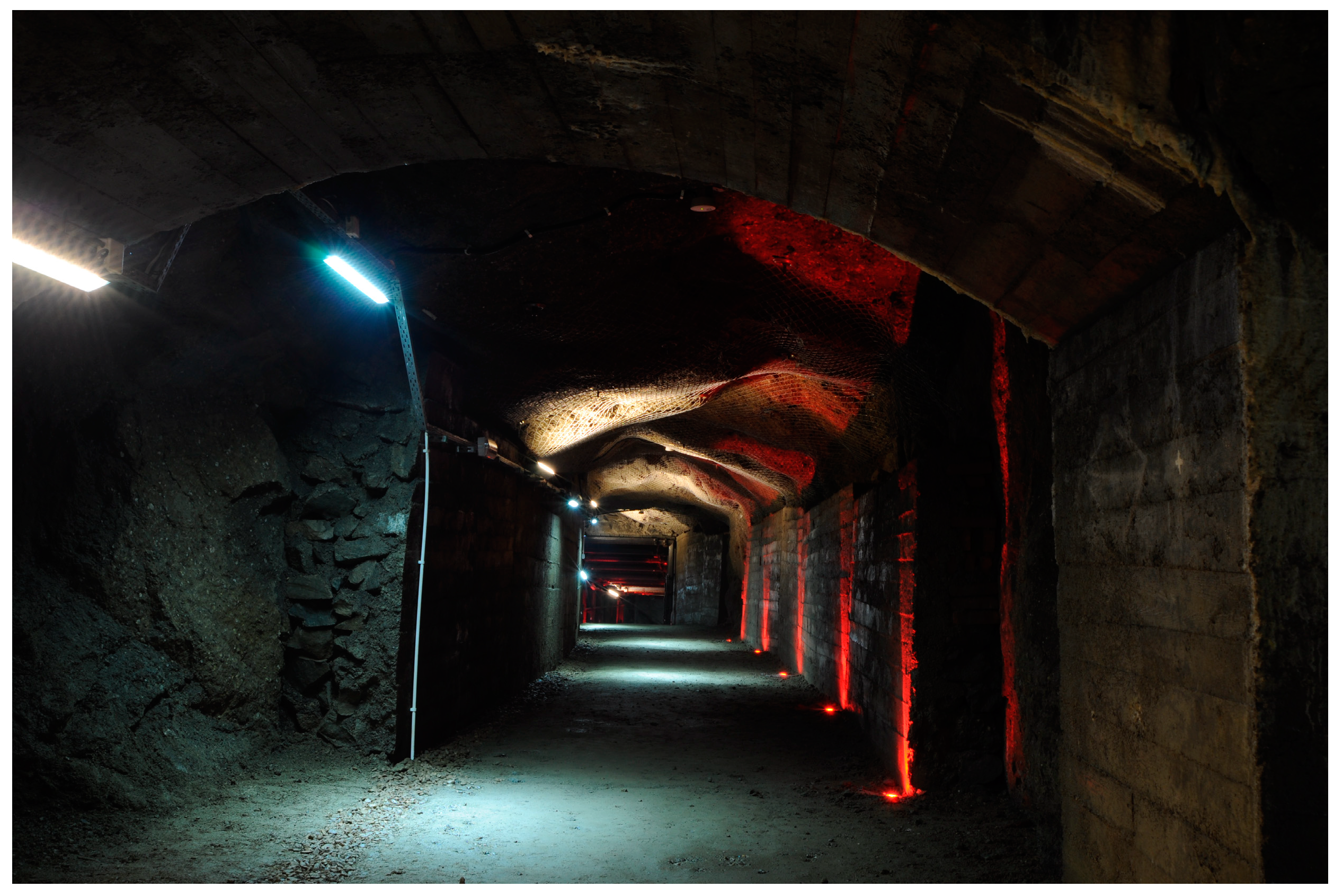


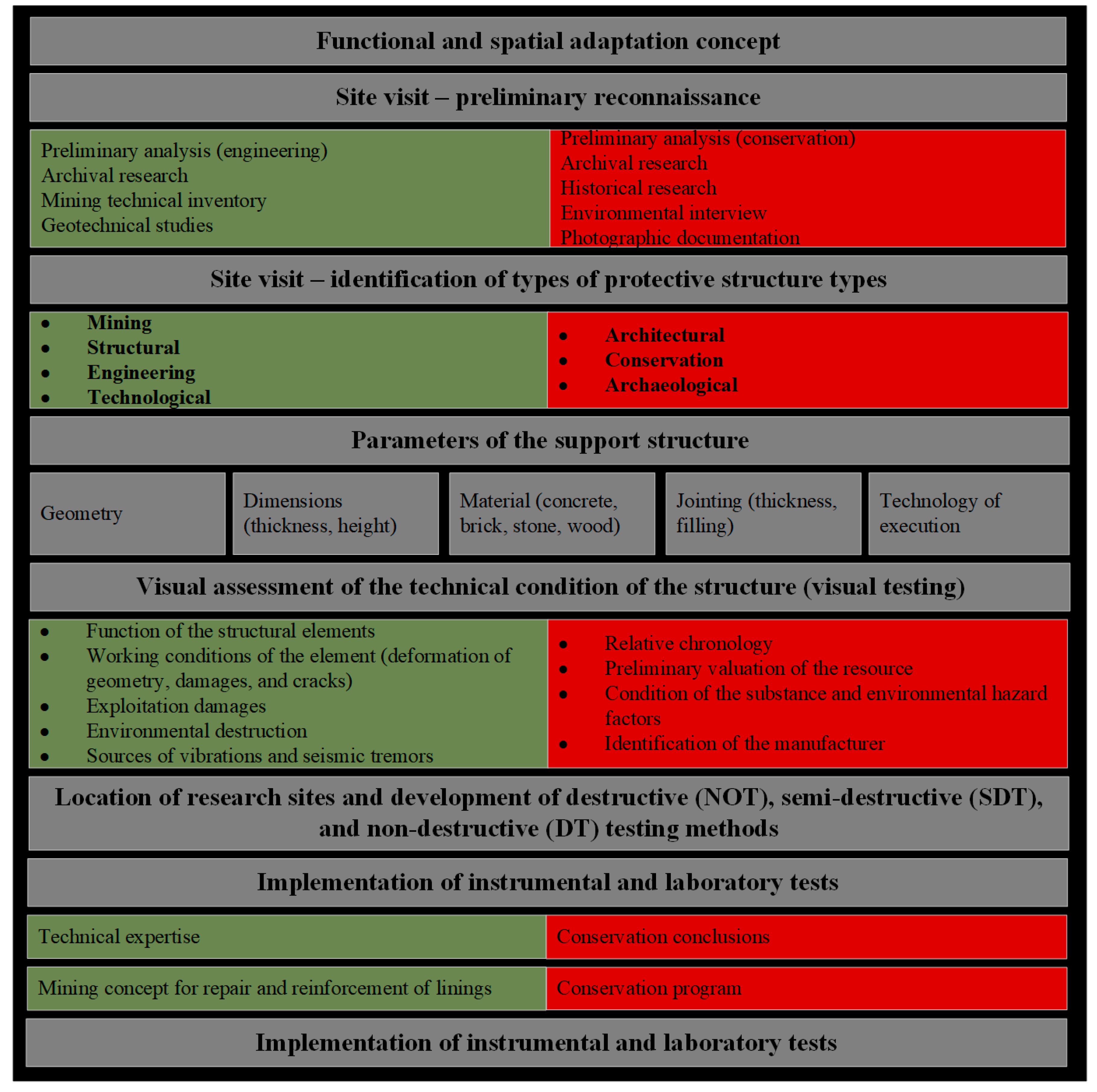
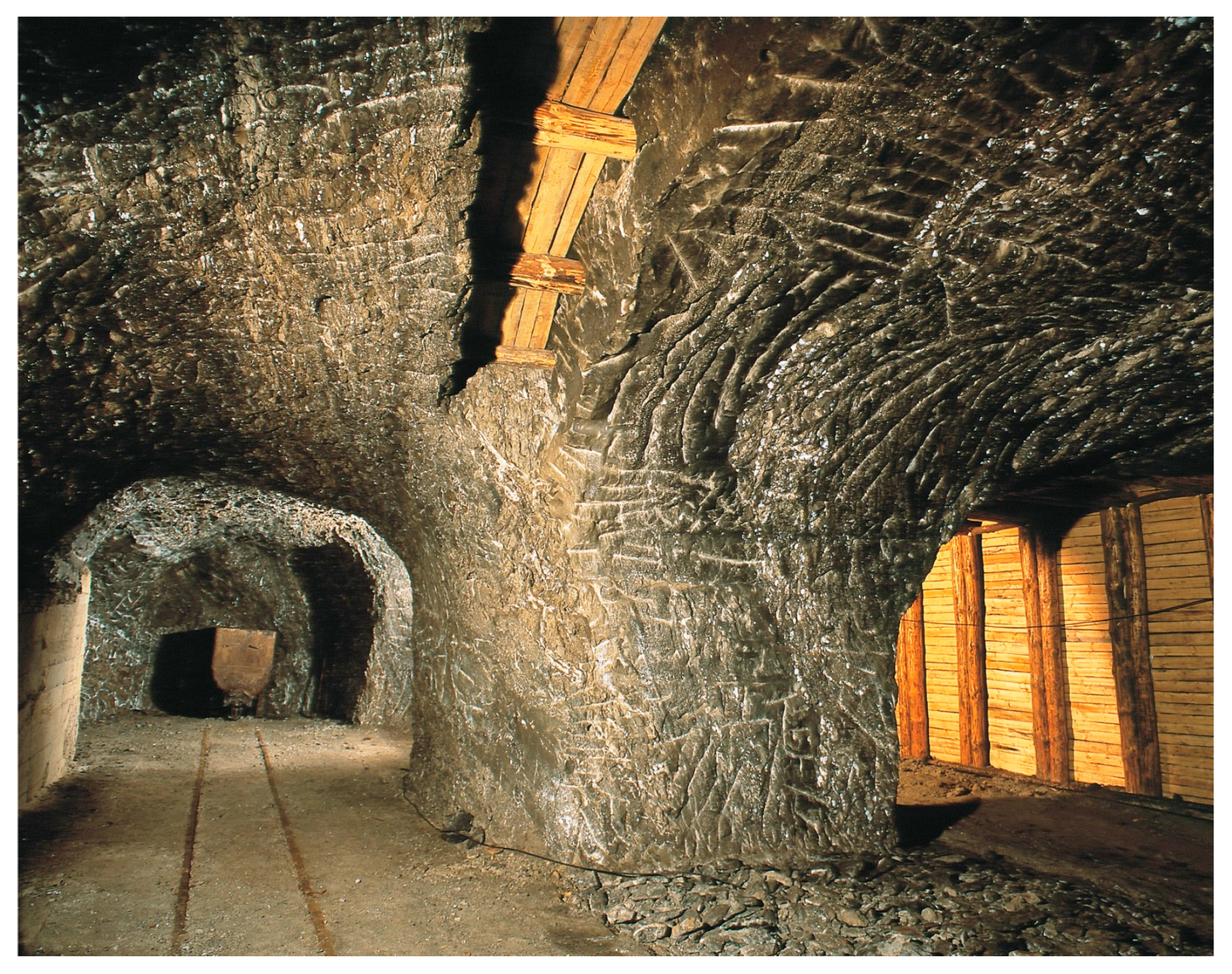

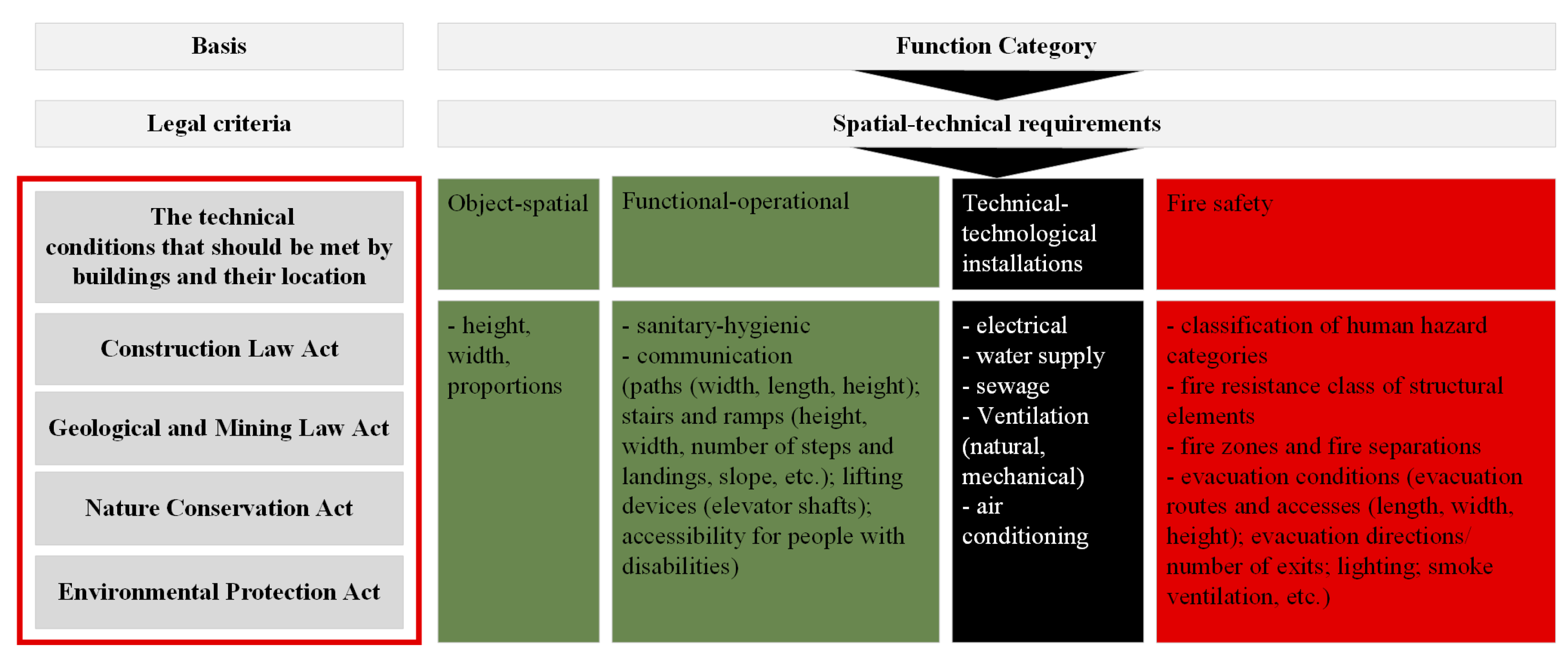


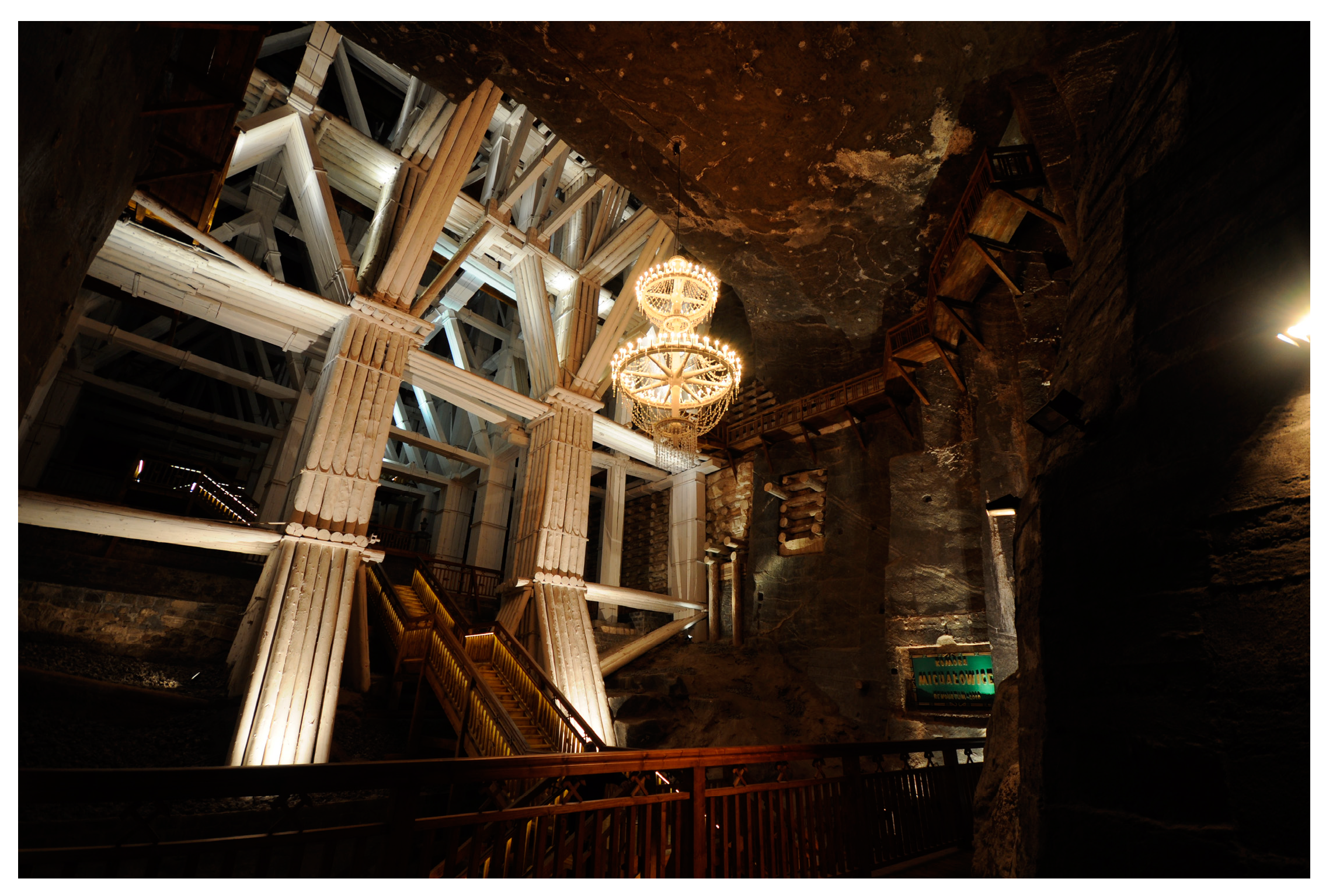

| Location | Type of Complex | Name of Object | Function | Date |
|---|---|---|---|---|
| * Bochnia | Post-industrial/mining/salt mine | Health Resort— Bochnia Salt Mine | UTR, Health (sanatorium), sports hall | XVIII century |
| Chełm | Mining—chalk mine | Chełm chalk undergrounds | UTR | 1972 |
| Jelenia Struga near Kowary | Mining/tunnels/uranium mine | Kowary tunnels—Jelenia Struga Center | UTR, UET, health (sanatorium) | 2000 |
| Kletno | Post-industrial/mining/uranium mine | Kletno uranium mine | UTR | 2002 |
| Kłodawa | Post-industrial/mining/salt mine | Kłodawa salt mine | UTR, MM, culture (concert hall) | 2004 |
| * Krzemionki | Mining/works/flint mine | Neolithic flint mine in Krzemionki Opatowskie | UTR | 1985 |
| Kowary | Mining/tunnels/uranium mine | Podgórze uranium mine | UTR | 2011 |
| Krobica/Mirsk | Mining/tunnel/tin mine | “Geopark—traces of former ore mining” in Krobica | UTR, UER (geopark) | 2013 |
| Nowa Ruda | Post-industrial/mining/coal mine | Underground tourist coal mine—mining museum in Nowa Ruda | UTR, MM | 1996 |
| Rybnik-Niewiadom | Post-industrial/mining/coal mine | Historic “Ignacy—Horym” Mine | UTR, MM | |
| * Tarnowskie Góry | Post-industrial/mining/silver mine | Silver ore mine, museum in Tarnowskie Góry, “Black Trout” tunnel | UTR, MM | 1976/1957 |
| Tomaszów Mazowiecki | Works/glass sand mine | Nagórzyckie caves | UTR | 2012 |
| * Wieliczka | Post-industrial/mining/salt mine | Wieliczka salt mine | UTR, MM, Health (sanatorium) | XVII century |
| Wiry | Mining/magnesite mine | Magnesite mine in Wiry | UTR | 2 June 2017 |
| Zabrze | Post-industrial/mining/coal mine | Guido mine in Zabrze, “Queen Luiza” mining open-air museum in Zabrze | UTR, MM | 1982/1985 |
| Szklary | Post-industrial/mining/nickel mine | Underground educational route in the “Robert” tunnel, “Szklary-Huta” mine | UER | 2013 |
| Złoty Stok | Post-industrial/mining/arsenic mine | Gold mine in Złoty Stok (underground mining and gold metallurgy museum) | UTR, MM | 1985 |
| Geometry | |
|---|---|
| Corridor excavations | Small cross-sectional to length ratio (shafts, drifts, crosscuts, and galleries). |
| Chamber excavations | Large excavations with a cross-section greater than 20 m2 (sublevels, various machine chambers, electrical rooms, underground workshops, etc.). |
| Extraction excavations | Various shapes depending on the thickness and inclination of the deposit (seams and veins) and the extraction method used (room-and-pillar, stope, wall, and chamber). |
| Function | Characteristic |
|---|---|
| Exploratory/ recognition | Research on boreholes |
| Access | Enables mining exploitation in underground mines; these are excavations connecting the deposit with the surface |
| Type | |
| Vertical (45°–90°) | Shaft—A corridor excavation with a slope greater than 45° and a depth greater than 200 m, with a cross-section greater than 15 m2, connecting the deposit with the surface |
| Winze—A vertical corridor excavation, with a depth of less than 200 m and a cross-section smaller than 14 m2, having an entry at the surface and leading down into the earth | |
| Dukla—A shallow (up to 30 m) winze with a small cross-section, made in hard rocks without lining | |
| Inclined (4°–45°) | Decline—A corridor excavation with a drilling direction from top to bottom |
| Rise—A corridor excavation with a drilling direction from bottom to top | |
| Horizontal (<4°) | Adit—A horizontal corridor excavation leading from the slope of the mountain into the deposits of ore, with one connection to the surface. Adit tunnels are used for gravitational drainage of excavations and transporting ore to the surface, as well as for providing access to the deposit |
| Crosscut—A corridor excavation in barren rocks from the shaft, crossing (perpendicular) to the line of the deposit | |
| Leveling—A corridor excavation driven in barren rocks from a crosscut, parallel to the extension of the seams | |
| Sublevel—A set of excavations located in direct proximity to the shaft on a given level | |
| Preparatory | Preparing the deposit for the most efficient extraction method |
| Type | |
| Horizontal | Gallery—A corridor excavation conducted horizontally or nearly horizontally (up to a 5° slope) |
| Inclined | Rise—A corridor excavation connecting two or more points located at different levels. Depending on the direction of the ore transport, it is called either a decline or incline |
| Extraction (operational) | Designed for extracting useful ore |
Disclaimer/Publisher’s Note: The statements, opinions and data contained in all publications are solely those of the individual author(s) and contributor(s) and not of MDPI and/or the editor(s). MDPI and/or the editor(s) disclaim responsibility for any injury to people or property resulting from any ideas, methods, instructions or products referred to in the content. |
© 2025 by the authors. Licensee MDPI, Basel, Switzerland. This article is an open access article distributed under the terms and conditions of the Creative Commons Attribution (CC BY) license (https://creativecommons.org/licenses/by/4.0/).
Share and Cite
Radziejowska, A.; Wieja, T. Evaluation of Functional and Spatial Characteristics of Historical Underground Mining Workings in the Context of Selecting a New Utility Function. Sustainability 2025, 17, 3301. https://doi.org/10.3390/su17083301
Radziejowska A, Wieja T. Evaluation of Functional and Spatial Characteristics of Historical Underground Mining Workings in the Context of Selecting a New Utility Function. Sustainability. 2025; 17(8):3301. https://doi.org/10.3390/su17083301
Chicago/Turabian StyleRadziejowska, Aleksandra, and Tomasz Wieja. 2025. "Evaluation of Functional and Spatial Characteristics of Historical Underground Mining Workings in the Context of Selecting a New Utility Function" Sustainability 17, no. 8: 3301. https://doi.org/10.3390/su17083301
APA StyleRadziejowska, A., & Wieja, T. (2025). Evaluation of Functional and Spatial Characteristics of Historical Underground Mining Workings in the Context of Selecting a New Utility Function. Sustainability, 17(8), 3301. https://doi.org/10.3390/su17083301










